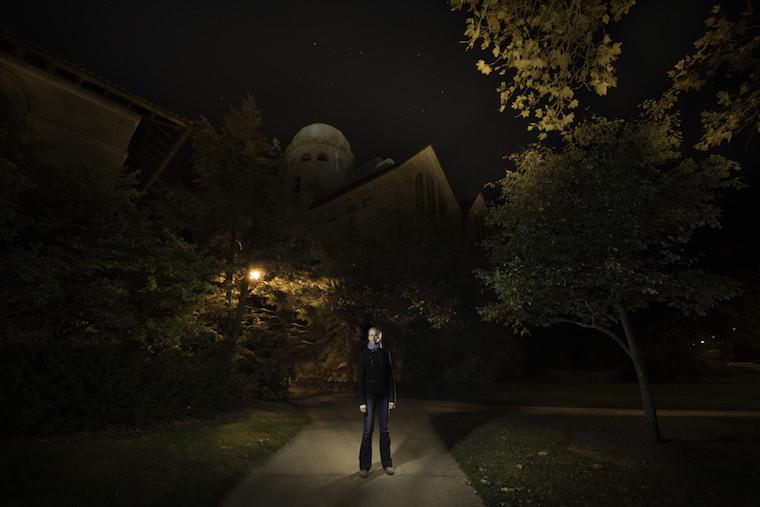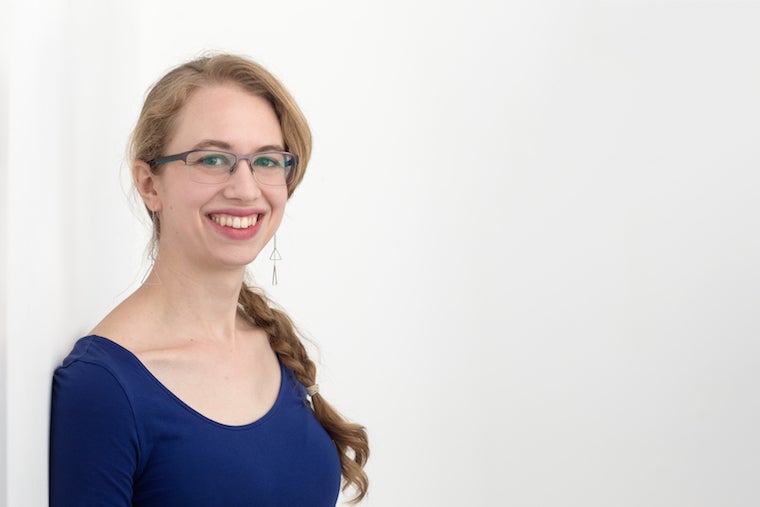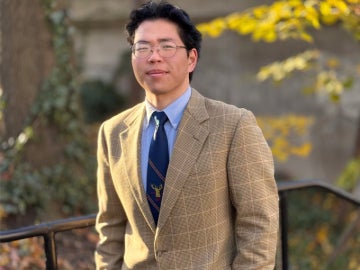The Astronomer is Here to Take Your Questions
October 18, 2017
Amanda Nagy

Assistant Professor of Physics Jillian Scudder stands in front of the Peters Hall observatory.
Photo credit: Yevhen Gulenko
Assistant Professor Jillian Scudder gets a lot of questions about the moon. For example, why do we only see one side of the moon?
The answer is because it’s tidally locked.
But what does that mean?
Scudder, who joined the Department of Physics and Astronomy this fall, realizes that the readily available answers to our questions about space often fail to explain the answer in the first place. It’s not because the majority of people don’t understand—it’s because most of the information we get from Googling isn’t presented in the way we need it.
To wit: The moon rotates around the Earth at the exact same speed as it rotates around its own axis, so that the same side of the moon is constantly facing the surface of the Earth. Any object which is found to be tidally locked will always have one side of itself facing the surface of the planet it’s orbiting.
Scudder goes into more thoughtful detail about tidal locking and responds to scores of other reader-submitted space questions on her blog, Astroquizzical. The post about the moon is one of the most frequently visited on her site.
“People are really curious about the moon because it’s accessible, and they can see it,” says Scudder, who came to Oberlin from a postdoctoral research position at the University of Sussex in Brighton, England. She grew up in Florida with the space shuttle program practically in her backyard—but more on that later.
Scudder started the blog when she was a PhD student at the University of Victoria in British Columbia. It was during a public outreach night hosted by her department that she made a non-academic discovery: People outside of the field are really curious about space.

“The department invited the public to talk to faculty and graduate students, and everyone had their own booth. I said I could do an “Ask an Astronomer” booth because that seemed easy. It was a three-hour event, and I had no more than 15 minutes of downtime. It made me think, I get this all the time. When I’m on an airplane and the person next to me asks what I do, they’re like, ‘I have so many questions about space!’ ”
As she realized the demand for more public outreach, she also wanted a creative outlet to offset her academic writing. The idea behind the blog has always been to answer questions submitted by readers—never questions that Scudder, a trained scientist, thinks people want to know.
“When you’re just starting out, it can be tricky to gain exposure. I thought it would crash and burn,” Scudder says. Four years later, she has a stack of 400 questions in the queue, as well as a forthcoming book compilation of her blog posts. With the working title Astroquizzical: A Curious Journey Through Your Cosmic Family Tree, the book is expected to be released in June 2018.
More of Scudder’s work can be found at Forbes, where she has been an independent science contributor for two years.
Making Space
In her research, Scudder is broadly interested in galaxy collisions, and understanding the resulting responses when galaxies smash into each other. “I’m looking for these violent interactions between galaxies and trying to figure out what happens in a specific collision, and why they work the way they do,” she explains. “If you have a collision between two galaxies, does it always form extra stars, or only sometimes; and if sometimes, then why is that?”
As an undergraduate, Scudder knew she was going to pursue the sciences, but astronomy wasn’t a career track she’d even considered until her third year at Macalester College.
“I can’t say this was my dream job since I was a child,” she jokes. In fact, she recalls thinking that rockets looked dangerous when she was a child. But that changed at age 14 when she went to space camp in Huntsville, Alabama. Growing up in the Gulf Coast of Florida, she could hear the double sonic boom of the space shuttles when they returned for landing. In school, classes would stop and go outside to watch the shuttles during takeoff.
“Looking back, it was pretty cool. You’d hear the BOOM-BOOM that rattled the windows in our house, and you’d think, ‘Oh, the space shuttle’s coming back to land.’ At the time, it was just part of growing up in Florida. I’m so sad that the space shuttle was retired.”
There’s another clue that Scudder was a likely candidate for her chosen field. In high school, she received the prestigious Girl Scout Gold Award, which is the highest achievement in the Girl Scouts organization. Only about 5 percent of eligible Girl Scouts earn the award for sustainable projects that have an impact in their communities.
Scudder’s project? Developing an astronomy curriculum for a third-grade class.
“In hindsight, there were some clues, but if you asked me my first or second year of college, I never would have told you that astronomy was something I was going to do,” she says.
It’s Never Aliens
Scudder’s courses this fall include an introductory physics course for majors and a first-year seminar called It’s Never Aliens: Understanding Astronomy in the News. The first-year seminar is a writing-intensive course that tackles reported discoveries in which the prevailing speculation is “maybe it’s aliens” and explores them more in depth.
“We’re figuring out how these events came up, why it’s not aliens, and why that’s interesting in its own right,” Scudder says. “We’re also keeping up with current events in astronomy.”
She says it’s been exciting to feed the curiosity of students in her first-year seminar. “My students are absolute sponges for information. I give them a little bit of information, and they’ll come back with a thousand questions. That has been the most rewarding part of teaching Oberlin students.”
You may also like…
Learning by Teaching: Oberlin Students Share Global Music with Young Learners
College and Conservatory students in PACE 103 prepare local children for an immersive community concert at Oberlin.
Nuiko Wadden ’02 Joins Oberlin Conservatory Faculty as Assistant Professor of Harp
The versatile musician brings extensive opera, orchestral, and contemporary music experience to her role
Leo Hidy ’23 Earns 2026 Marshall Scholarship
Leo Hidy ’23, a comparative American studies major who also studied business and economics while at Oberlin, has received a 2026 Marshall Scholarship that will fund two years of graduate study in the UK.


